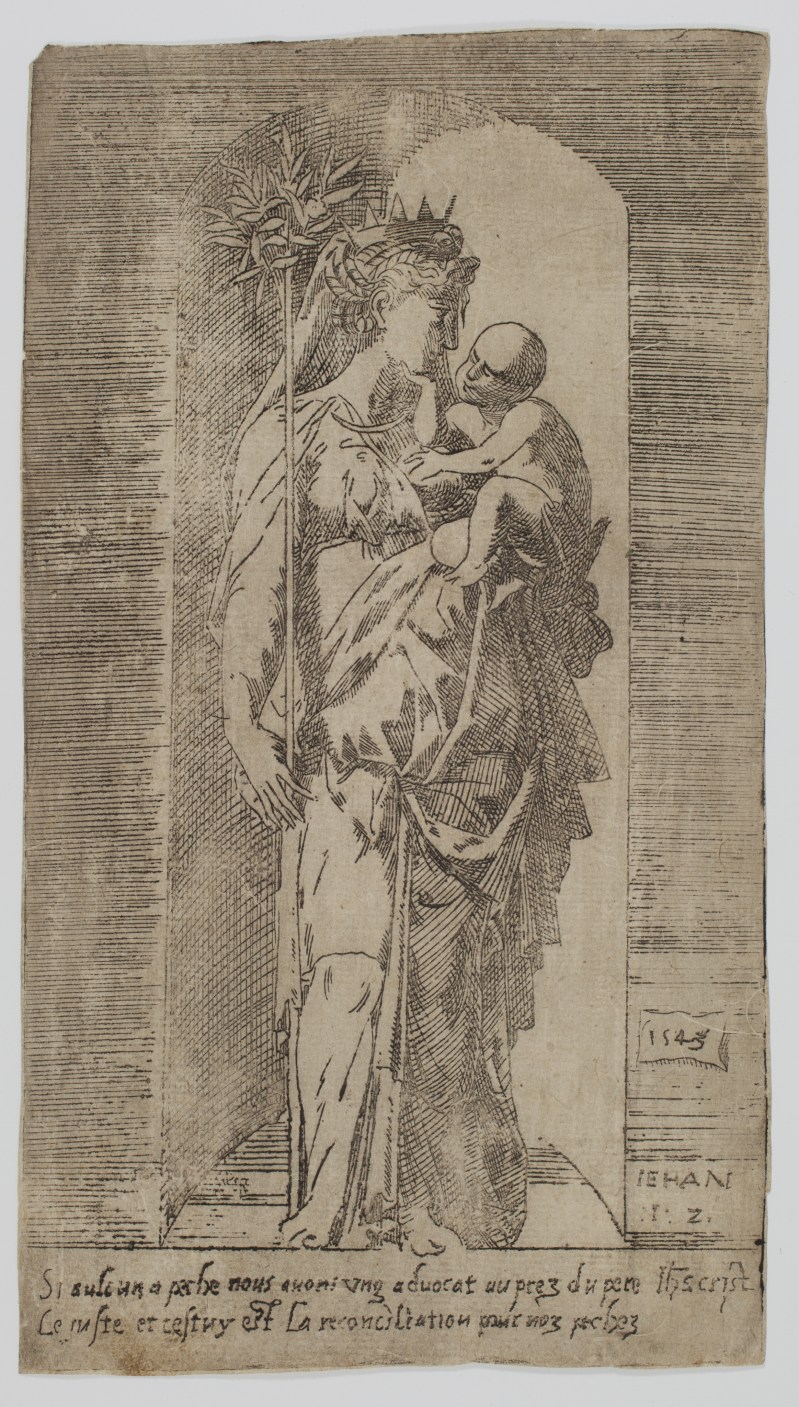Geoffroy DUMONSTIER : The Crowned Virgin in a niche - 1543
SOLD
Etching, 228 x 127 mm. IFF 11B, Robert-Dumesnil 12, Zerner GD 12.
Very fine impression printed on watermarked laid paper (hand crowned with a flower, four fingers clasped, thumb spread, laced at the wrist, with the initials PB). Impression trimmed on or just outside the borderline. A very tiny paper loss in the upper left corner and on the left edge. Tiny split in the shadow of the niche on the left. A few very small surface abrasions on the reverse. Generally in good condition.
Extremely rare. We only know of three other impressions. Two are at the Bibliothèque nationale de France, one at the Metropolitan Museum of Art. All Dumonstier's prints are of the greatest rarity, known in one, two or three impressions only.
The quote etched at the bottom is taken from the First Epistle of Saint John (chapter two, verse 1): Si aulcun a peche nous avons ung advocat auprez du père Ihs crist // Le iuste et cestuy est La reconciliation pour nos pechez. [But if anyone does sin, we have an Advocate with the Father, Jesus Christ the righteous one, He is expiation for our sins].
The Crowned Virgin is one of Dumonstier's three etchings of figures in niches. In The Virgin and Child standing in a niche (Zerner GD 13), the Mother of God can only be identified by the etched letter borrowed from a passage in Paul's first Epistle to Timothy. Unlike the Crowned Virgin in a niche, she has no crown or other attribute. The two Virgins, on the other hand, are both barefoot, "of great humility", but dressed in a drapery "intricate with folds tied over the belly [which] confers some majesty" (Nathalie Strasser, p. 148). The third figure is a Saint holding a palm leaf (Zerner GD 14). Nathalie Strasser emphasizes the "extreme simplicity" of the niche's design, "delineated by an almost mechanical hatching that contributes to the definition of a vigorous, cold chiaroscuro (should we speak of luminism?), which is Dumoûtier's trademark". Contours are "lightly accentuated, the line breaking in places", which is also typical of the artist's style.
Dumonstier's rapid, vigorous, unacademic style is reflected in the impression's careless printing, which is typical of the Fontainebleau school. Nathalie Strasser comments on the impression of The Virgin and Child standing in a niche from the collection of Georg Baselitz: "The impression, which is a little pale and irregularly inked (the Fontainebleau workshop is accustomed to this expeditious printing), shows lighter areas in the cross-hatching." (p. 148) Geoffroy Dumonstier was indeed employed as a painter at the Château de Fontainebleau around 1537-1540, where he worked under the direction of Rosso Fiorentino. Catherine Jenkins believes, however, that Dumonstier's prints were probably not printed in the Fontainebleau workshop itself, as the most common watermark on Dumonstier's prints (the large hand surmounted by a flower with initials) is not found on any of the prints of the Fontainebleau school.
The life and work of Geoffroy Dumonstier are currently the subject of a study that will culminate in a major exhibition at the Archives départementales de la Seine-Maritime in autumn 2024, in collaboration with the Musée du Louvre and the Bibliothèque nationale de France. The exhibition will be accompanied by a catalog featuring studies of the artist's work, as well as a catalogue raisonné.
References: Henri Zerner, École de Fontainebleau : gravures, 1969; Nathalie Strasser, Rainer Michael Mason, Georg Baselitz, Le Beau Style (1520 - 1620): gravures maniéristes de la collection Georg Baselitz, 2002; Catherine Jenkins, Prints at the Court of Fontainebleau, c. 1542-47, 2017.



